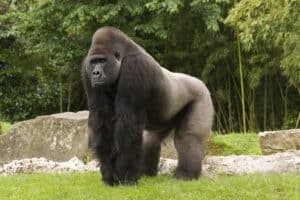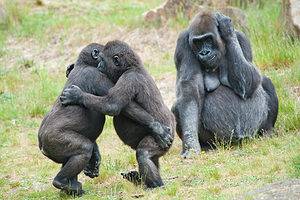Have you ever seen a gorilla make a teeth-baring facial expression and thought, “Wow! Those are some big teeth!”? As the world’s largest primate, gorillas are famous in the animal kingdom for their impressive size in general, and their teeth match these large proportions. This article will review what influences have affected the evolution of gorilla teeth and how their teeth compare to ours. So, why are gorilla teeth so big? Let’s find out!
What are Gorillas and Where do they Live?
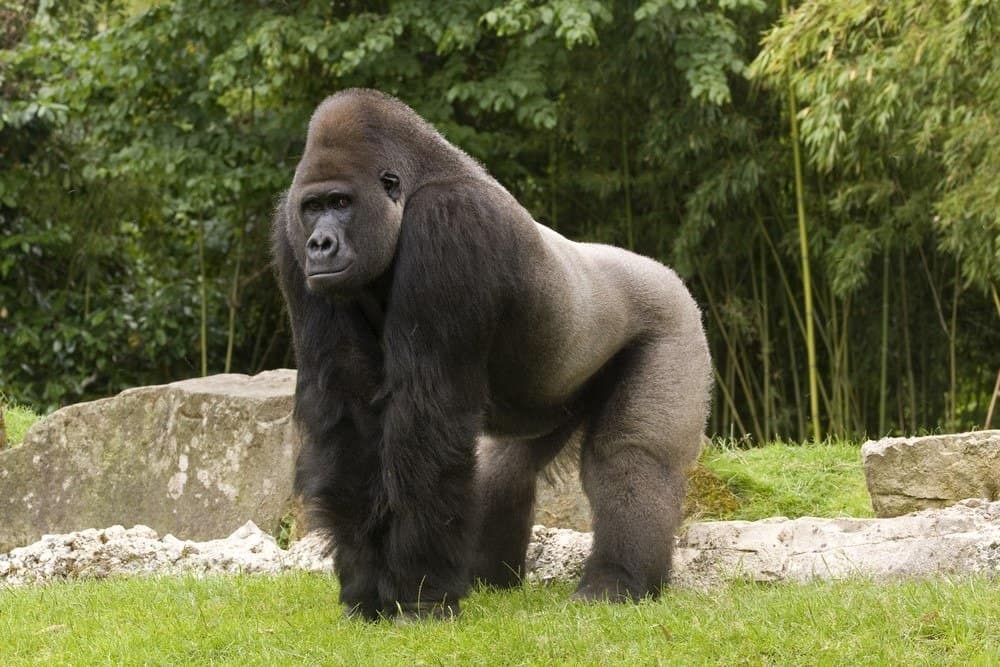
Big silverback male Western lowland gorilla
©Andreas Rose/Shutterstock.com
Gorillas are species of large mammals that live in multiple African countries. They have their own genus called Gorilla. Within this genus there are two species that each have two subspecies:
- Gorilla gorilla (Western gorillas) Both subspecies live in west central Africa:
- G. g. gorilla (Western lowland gorillas)
- G. g. diehli (Cross-river gorillas)
- Gorilla beringei (Eastern gorillas) Subspecies both live in east central Africa:
- G. b. beringei (Mountain gorillas)
- G. b. graueri (Eastern lowland gorillas)
There is significant genetic variation between gorilla species and subspecies. Eastern and Western gorillas are geographically separated by the Congo River and its associated tributary rivers. The different species therefore inhabit a variety of habitats. Mountain gorillas live at higher elevations in montane forest habitats. Western lowland gorillas live in montane and secondary forests as well as lowland swamp areas. Cross-river gorillas live in rainforests and dense jungle habitats. Eastern lowland gorillas inhabit tropical forests and jungles in mountainous regions. Habitat is important to understanding an animal’s teeth because different food resources are available in different areas.
How are Gorillas Related to Humans?
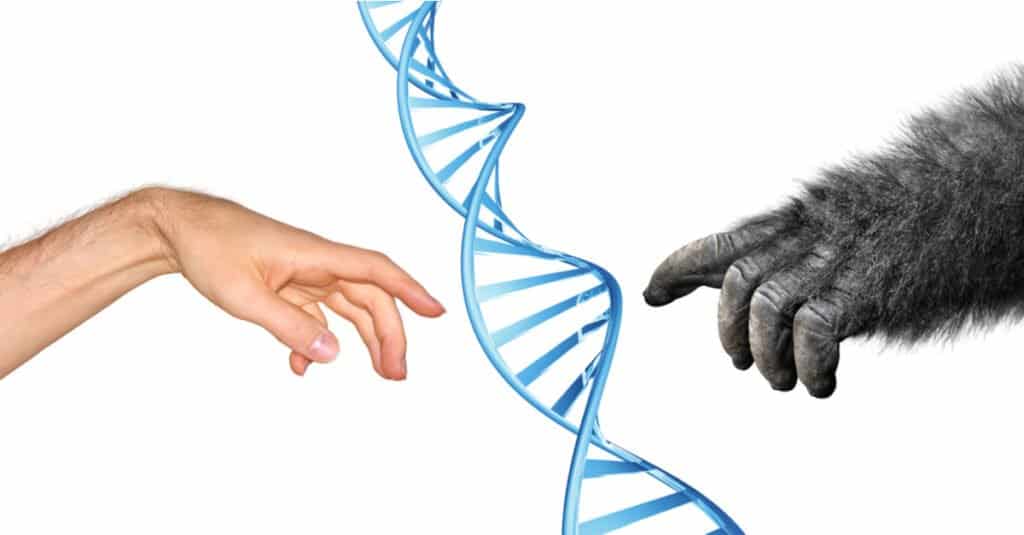
Humans and gorilla DNA is 98% similar
©David Carillet/Shutterstock.com
Gorillas and humans are both primates. Within the order Primates, gorillas and humans belong to the same subfamily called Homininae. This subfamily diverges into tribes Gorillini and Hominini which is where humans and gorillas share a common ancestor around 10 million years ago. The tribe Hominini includes humans, bonobos, and chimpanzees, whereas the tribe Gorillini includes only gorilla species. Gorillas are therefore the next most closely related living species to humans after chimpanzees and bonobos.
Even though 10 million year seems like a long time, it is a short period considering how long ago the major animal classes diverged (mammals, fish, reptiles, amphibians, birds, and invertebrates). Mammals arose 210 million years ago! To read more about early mammal evolution, check out this article. Humans and gorillas are so closely related, in fact, they share 98% of their DNA. An unfortunate side-effect of this close evolutionary relationship, however, is that zoonotic disease can spread easily between species. In 2004, an Ebola outbreak that greatly affected human populations also killed 95% of a Western lowland gorilla population in the Democratic Republic of Congo. During the Covid-19 pandemic, humans transmitted the coronavirus to captive gorillas and studies projected that an outbreak in the wild was possible, however, because of air circulation outdoors their risk was low.
How Does Diet Affect Size and Shape of Teeth?
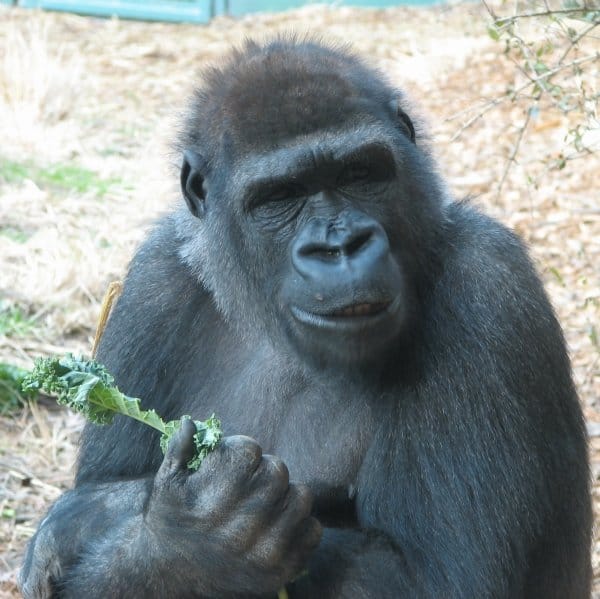
Mountain gorilla eating a leaf
©Ltshears – Public Domain
Except for occasional insects, gorillas are herbivores and feed primarily on leafy foliage. Diet varies between gorilla species but broadly includes fruits when ripe, foliage, roots, shoots, bark, and other plant materials. These foods are highly fibrous and can be tough to process and digest. Western lowland gorillas and Eastern lowland gorillas eat more fruit than mountain gorillas or cross-river gorillas, which is much softer than other plant materials.
Diet has tremendous impact on the evolution of teeth because different sizes or shapes of teeth may be more efficient at processing different materials. Also, animals that rely on plants for food must eat a large volume because it is not a nutrient rich food source. Gorillas therefore have large teeth capable of grinding and breaking down substantial volumes of tough material.
Similarly, other ape species like chimpanzees and humans have teeth specialized for their diet. Chimpanzees have teeth specialized for an omnivorous diet that includes tough meat and plants. Enlarged canines are essential for a diet that includes meat. Early human species also had larger canine teeth, but throughout human evolution our teeth have become much smaller with less prominent canines. This is because with the discovery of fire, the ability to cook our food has made it much easier to eat. Over time, human teeth evolved to be smaller as food preparation made chewing easier.
What Other Factors Affect how Gorilla Teeth Have Evolved?
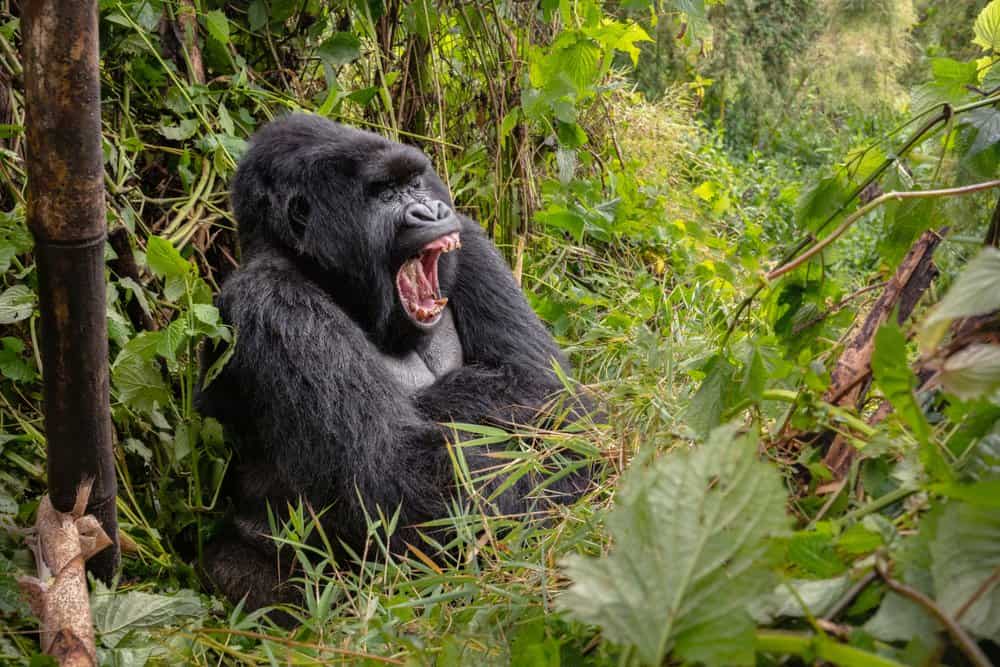
This female Mountain gorilla does not have the large canines of her male counterparts
©PhotocechCZ/Shutterstock.com
There is a marked difference in tooth size between male and female gorillas within the same species. This is called sexual dimorphism and is the result of an evolutionary force called sexual selection. Sexual dimorphism is when there is a distinct characteristic that differs between sexes of the same species. This happens over evolutionary time within a species when there is competition amongst one sex for mating opportunities with the opposite sex.
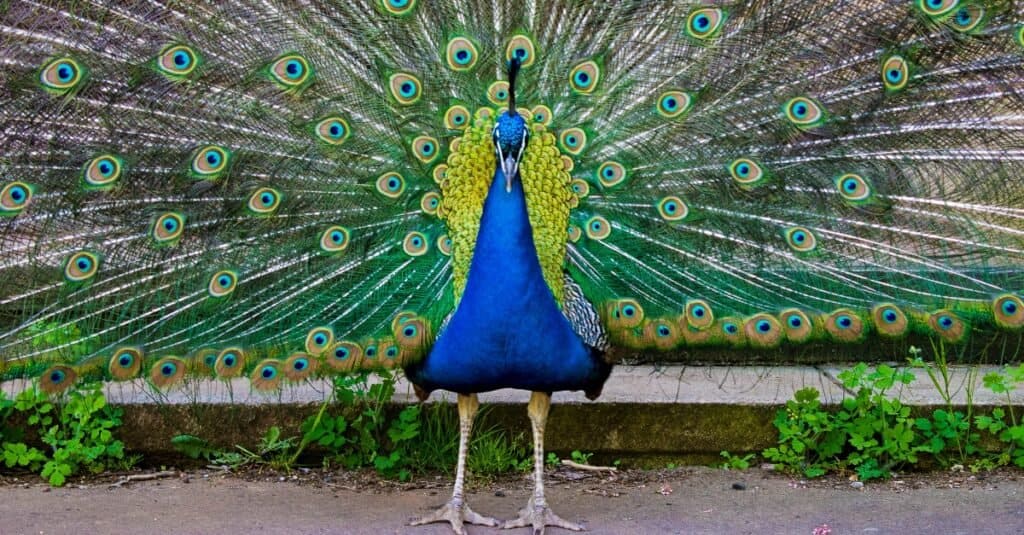
Male peacocks have large colorful tail feathers necessary for winning mates
©iStock.com/Anna_Brothankova
For example, in peafowl, males must compete for mating opportunities with females. Males with more elaborate tail feathers are chosen by females as suitable mates more frequently and therefore reproduce more. Over several generations, elaborately tailed peacocks will have the most offspring and there will be more fancy tails in each consecutive generation. The average male tail will evolve to be increasingly large and colorful as long as it provides a selective advantage that helps them win female mates.
Similar to peafowl, in gorillas there is competition amongst males for dominance and access to females. Gorillas most often live in harems which consist of a single dominant male with several reproductive females. Male gorillas that are large bodied with large canine teeth are better able to protect the females in their harem from smaller males and will be more attractive mates. The larger male will then likely be more successful reproducing than smaller males. Genes for large bodies and large canines therefore pass on to the next generation with greater frequency than genes for small bodies and male gorillas evolve sexually dimorphic characteristics over time. There is not significant sexual dimorphism present in human teeth.
How Big are Gorilla Teeth?
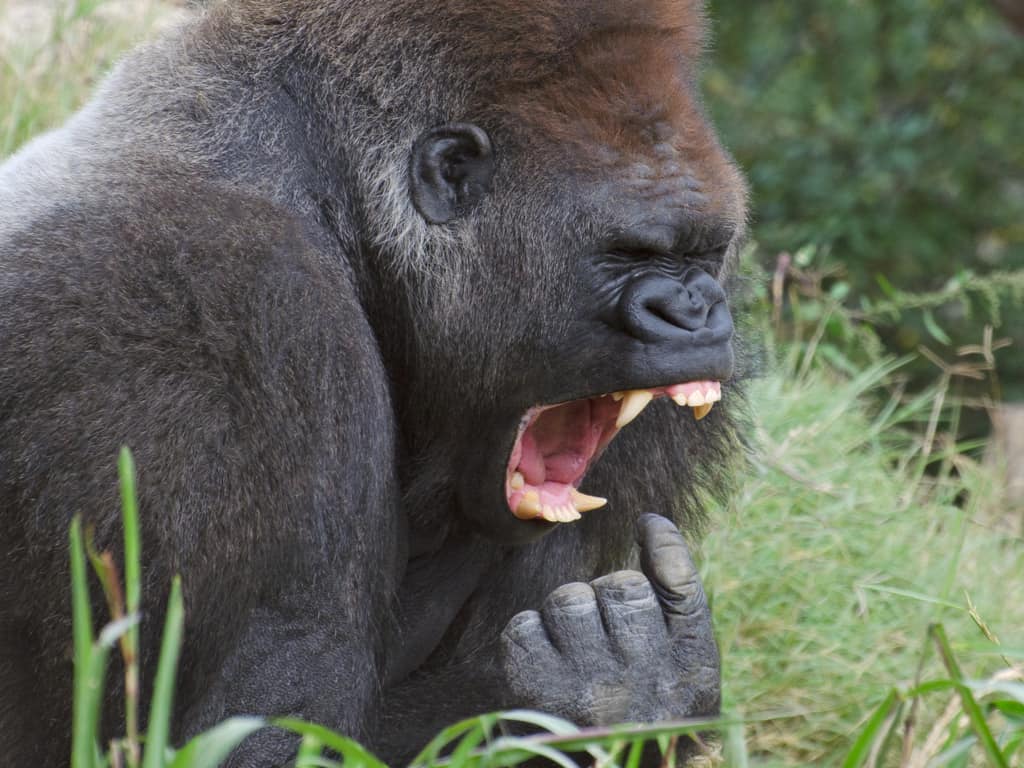
Male gorillas have very large canine teeth
©BDMPhoto/Shutterstock.com
On average, male gorilla canine teeth are two inches long! Female canines do not grow as long. Gorillas have 32 teeth, just like humans. These teeth include molars, premolars, canines, and incisors. Gorillas also have the same dental formula as humans which means they have the same distribution of these different types of teeth. The common dental formula of the great ape species is 2:1:2:3 meaning that counting from the middle front tooth, there are two incisors, one canine, two premolars, and three molars on each side of the mouth on the top and bottom.
Tooth size varies amongst gorilla species. Eastern lowland gorillas have larger teeth than Western lowland gorillas and mountain gorillas. The morphology, or shape, of their teeth varies by species as well. For example, the proportions of molar cusp size on Western lowland gorillas and mountain gorillas are significantly different. To read more about tooth size and shape amongst the different gorilla species, check out this article.
Some Fun Facts!
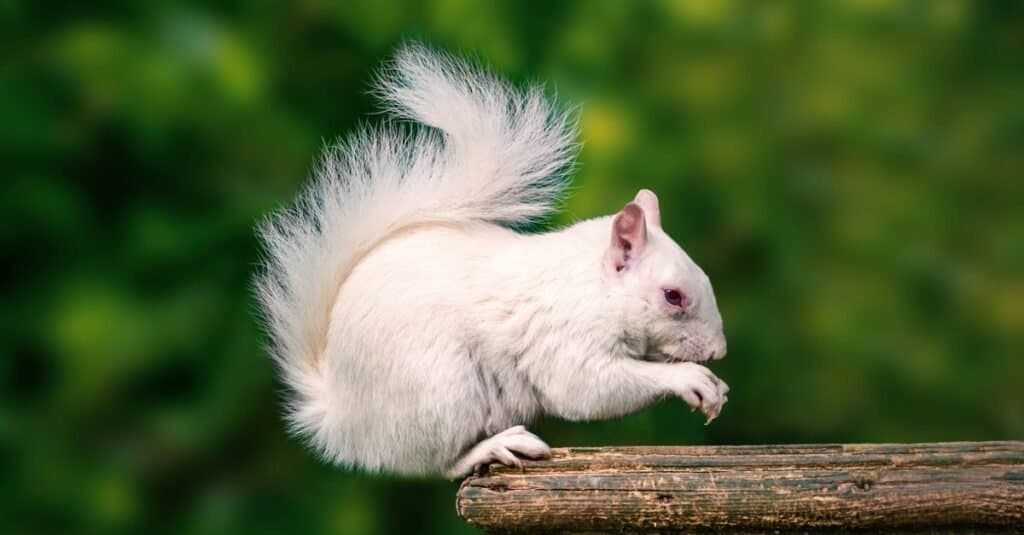
Albinism occurs throughout the animal kingdom and is characterized by lack of pigment often in the skin, eyes, and hair or fur
©Christine Bird/Shutterstock.com
One fun fact is that there is an ancient ape species called Chororapithecus that was identified solely based on fossilized teeth. This species existed approximately 8 million years ago and was discovered during a 2005-2007 expedition. Interestingly, the teeth are remarkably similar in size and shape to modern gorilla teeth!
Another fun fact is that the only known albino gorilla was a Western lowland gorilla named Snowflake. He was captured in Spanish Guinea in 1966 and lived to be 38 years old, dying in 2003. Snowflake had oculocutaneous albinism causing lack of pigment in the eyes, skin, and hair. Snowflake fathered 22 offspring but none of them were albino.
The photo featured at the top of this post is © Andrew Witcher/Shutterstock.com
Thank you for reading! Have some feedback for us? Contact the AZ Animals editorial team.



